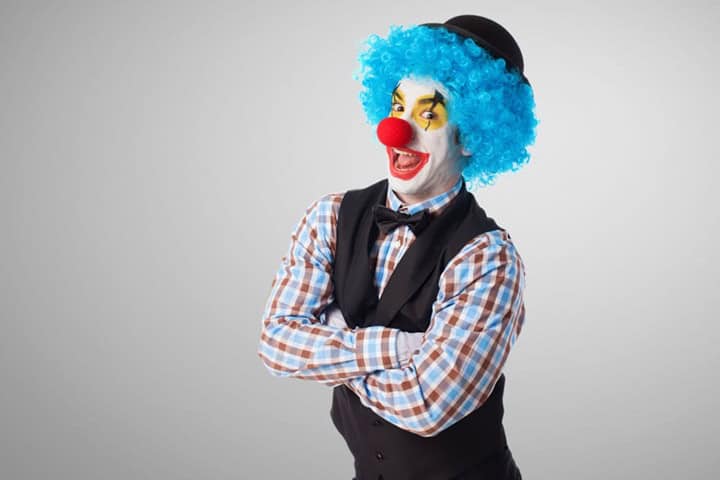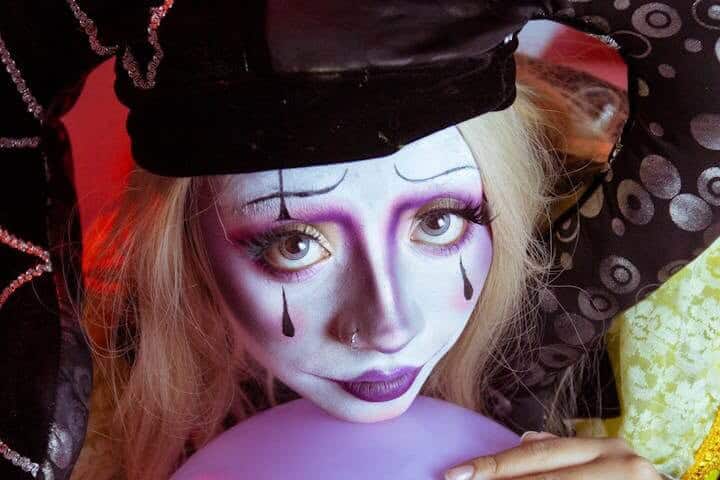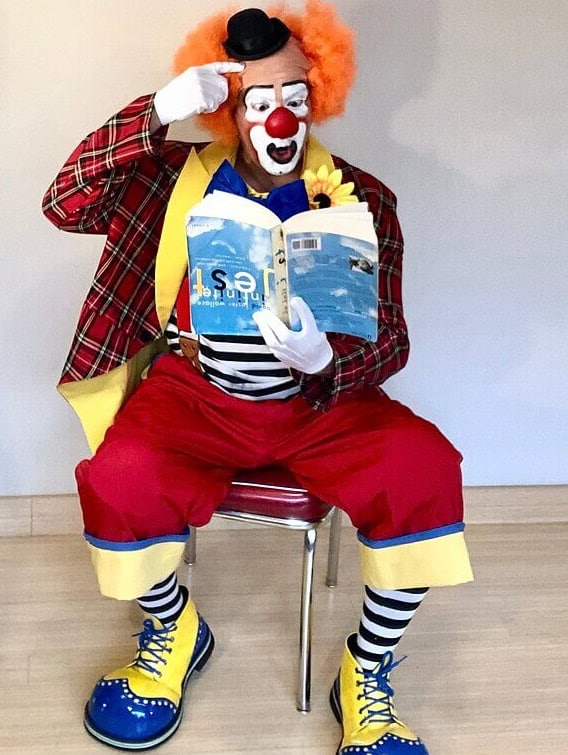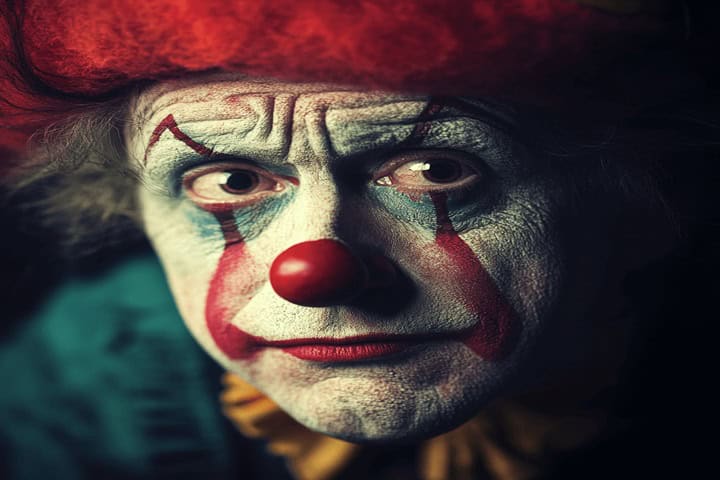Traditional Clown Makeup Tutorial For Beginners: Here’s How to Clown
1st October, 2024
Let’s put a smile on that face! Discover the art of clown makeup and transform into the star of any show.
The clown has become a staple with makeup routines for hundreds of years, whether it’s in the circus or on the stage. But what makes the clown so iconic, are there other unique clown makeup styles aside from the traditional, and what products can you use? In this article, we will answer all these questions and more as we delve into our traditional clown makeup tutorial for beginners. Explore the vibrant world of clown makeup, where colours and creativity meet to express your unique character.
Key points:
- Learn the basics of traditional and modern clown makeup.
- Step-by-step guide to applying clown makeup, from foundation to finishing touches.
- Discover the different clown personas: Whiteface, Auguste, and the Tramp/Hobo.
- Tips on how to make your clown makeup last longer and stand out.
- Recommended products and accessories for the perfect clown look.
Discovering Your Clown Persona
Clown makeup is not just a form of disguise but a distinctive expression of your inner theatrical character. But what should you consider before crafting your clown makeup?
- Colour Your Mood: Choosing the right colours is important in clown makeup. Bright, vivid colours can transform you into a lively and energetic clown, while darker tones might lend themselves to a more sombre or mischievous character. If pink makes you happy, why not create a makeup look that features various shades of pink, radiating joy and playfulness?
- Facial Expressions: The essence of clowning lies in exaggeration. A clown’s face is a canvas for expressing emotions in a theatrical manner. Beginners might start with simple expressions and evolve as they become more comfortable with their makeup skills.
With that being said, here is what makeup products and tools you will need to craft your perfect clown makeup:
- A high-quality makeup hydra sponge.
- White clown makeup: Ben Nye Aqua Paint Cloud White.
- Setting powder: Ben Nye Super White Powder.
Accessories like oversized ties, colourful wigs, or even a classic clown nose can significantly aid your clown persona. Each accessory should complement the overall makeup theme and character you’ve chosen, adding layers to the story you’re telling. All these can be found within our clown makeup range.
Here is how to make a wig yourself if you would prefer one over a store bought one.
Step-by-Step Guide to Applying Clown Make up

Creating the perfect clown look involves a series of steps that transform you from the everyday to the extraordinary. Follow this guide to master the art of clown makeup, ensuring your character comes to life vividly and vibrantly.
1. Prepare Your Canvas
Simply put: Wash your face.
Start with a fresh, clean face. Removing any oils, makeup, or dirt ensures that your clown makeup applies smoothly and stays put.
This initial step sets the stage for a professional-looking application, crucial for both beginner easy clown makeup and traditional clown make up enthusiasts.
2. Foundation Setup
Now, it’s time to mix your white makeup with water.
For those new to clown make up, begin with a water-based option like Ben Nye Aqua Paint Cloud White.
This type of makeup is easier to handle and less intimidating for beginner clowns. Mix a small amount of water with the white makeup to achieve a paint-like consistency, testing it on the back of your hand. This step is pivotal as it forms the base of your clown face.
3. Application of Base Layer
Next up, start covering your face in white makeup.
Apply the white foundation evenly across your face, starting from the centre and working your way out.
Ensure you cover all areas, including under the eyes and around the edges of your face, which are often missed. If aiming for a more intense or gothic clown look, consider adding extra layers to deepen the white base.
3.1. Setting Your Base
Note: This can also be done after applying coloured makeup if preferred.
If using setting powder at this stage, apply it lightly with a puff to avoid makeup smudging throughout your performance. Focus on high-movement areas like the forehead, nose, and chin, which tend to lose makeup first.
Defining Your Brows
Here, you can begin colouring them in and put mascara on your brows.
Select a vibrant colour from the Ben Nye magicake classic palette —perhaps a fiery red to draw attention to your expressive brows. Wet the crayon slightly, dab off the excess, and apply it over your eyebrows. Remember, perfection isn’t the goal here; expression is. Clown makeup is forgiving in its exaggerated style.
After colouring, use mascara to improve and define your eyebrow hairs further. Applying mascara in the opposite direction of hair growth adds volume and depth, making your expressions larger than life.
Dramatise Your Eyes
Now, it’s time to add some coloured eyeliner, eyeshadow, and fake eyelashes.
Using the Ben Nye magicake classic palette, choose colours that will complement your clown persona. For a classic look, red, black, and white shades are particularly striking.
Moisten the crayon with a bit of water, remove any excess by dabbing it on a towel, and apply.
Start from the inner corner of your eye, moving outward, and blend into your base layer. This might not create a perfect line, but the slight imperfection adds to the whimsical nature of clown make up.
For the eyelids, use the same crayon as an eyeshadow, applying it over the entire lid. Be patient and keep your eyes closed until the colour dries to avoid smudging.
To complete the clown eye makeup, apply a pair of dramatic fake lashes, advancing both the size and expressiveness of your eyes. Adding a thin line of black eyeliner along the tear duct and above the upper lash line will further define the eyes.
Lively Lips
Here, you can start colouring in those suckers.
Start by outlining your lips with a red eyeliner crayon, filling them in to create a solid base colour. For an avant-garde touch, apply black lipstick to the inner parts of your lips, blending outward into the red to create a dynamic two-tone effect. This technique adds depth and intensity to your look, ideal for both traditional clown makeup and more modern interpretations.
Creative Details
Finally, it’s time to make your clown make up your own and take it to the next level!
Final touches are what set your clown makeup apart. Utilise your black eyeliner or any other vivid colours from your palette to add unique details. Consider drawing whimsical designs such as stars around your eyes, sunbursts on your forehead, or even playful freckles across your cheeks. Each detail contributes to the storytelling aspect of your clown character.
Here are a few ideas:
- Draw small hearts or stars at the corners of your eyes to add sparkle.
- Sketch droopy triangles under your eyes for a comically sad look, or use red to create exaggerated cheeky cheeks.
- Instead of a traditional clown nose, paint a large, vibrant dot on your nose, choosing a colour that stands out against your white base.
Setting Your Masterpiece
Lastly, use your puff to apply the setting powder.
To ensure your clown makeup remains vibrant and intact throughout your performance, setting powder is essential. Apply it carefully to avoid dulling the vivid colours you’ve just applied.
Start with your forehead, then gently dab your way down to the nose, cheeks, and chin. Be cautious around the eyes to avoid compromising your false lashes. A light touch is key; too much powder can obscure the detailed work you’ve done.
For everything in one go, equip this Mehron clown character kit.
3 Main Clown Face Types
Clown makeup can vary significantly depending on the character you choose to portray. Here’s a quick guide to the three main types of clown faces, which utilise different techniques and styles of traditional clown make up.
1. Whiteface Clown

The Whiteface clown is often seen as the classical clown, with dedicated, neat features outlined in bold colours like red, blue, or black.
This look requires a solid base of white face paint covering the entire face and neck. Accents like a shiny, exaggerated nose, and high, arched eyebrows in black add to the theatrical effect. Red face paint may be used to highlight the mouth and cheeks, giving the Whiteface clown a distinctive, polished appearance.
2. Auguste Clown

Begin with a base of light red or pink face paint across the entire face and neck. White makeup around the eyes and mouth creates a striking contrast, while a big, bold, red nose is central to this look. Cheeks are often painted red, and the exaggerated features are highlighted with black eyeliner to emphasise the expressive nature of the Auguste clown.
3. Tramp Clown

The Tramp or Hobo clown offers a more subdued and often melancholic look.
This style uses a flesh-tone base with white highlights around the eyes and mouth to mimic a weary expression. A grey or black paint simulates a beard or stubble, adding to the Tramp’s rugged appearance. The nose is typically red or flesh-toned, and minimal red paint is used on the cheeks to keep the look understated yet expressive.
The Importance of High-Quality Makeup
Professional brands like Ben Nye, Kryolan, Mehron, and Treasure House are renowned for their quality in the clowning community.
These brands are specifically designed for long hours of wear which is essential during performances. Unlike generic or water-based makeups that are often marketed for Halloween and tend to flake or wear off easily, professional clown makeup brands offer durability and vibrant colour that lasts, ensuring your appearance remains intact and bright throughout your act.
After all, generic brands may contain harsh chemicals that can irritate the skin, especially when worn frequently or for long periods. Professional makeup, on the other hand, is designed to be gentle, preventing the common skin irritations associated with lower-quality products, whilst also being vegan and cruelty-free.
How to Keep Your Clown Nose in Place
A clown’s nose is a signature part of the costume, but keeping it securely attached can be a challenge. Professional clowns rely on specific adhesives designed for theatrical use—available in both latex and non-latex formulas to accommodate different skin types and sensitivities.
To remove the nose, using a suitable adhesive remover will protect your skin and ensure the nose is ready for its next use.
How to Remove Clown Makeup
After a performance, removing your makeup is as important as applying it. Leaving makeup on for too long, especially while sleeping, can lead to skin irritation or breakouts. Here are some gentle, effective methods to remove heavy clown makeup:
- Baby Oil and Makeup Removers are excellent for dissolving heavy grease paint, making it easier to wipe off, whilst being gentle on the skin.
- Cold Cream has deep cleansing properties, meaning it can remove makeup thoroughly while soothing the skin.
- Olive oil is great for stubborn makeup residue; a bit of warm olive oil can help break down the grease, allowing for easy removal with a simple face wash.
- Following up with a gentle facial soap or baby shampoo will remove any oily residue left behind, ensuring your pores are clear and your skin is refreshed. For those on the go, baby wipes can be a convenient option to quickly remove makeup without harsh scrubbing.
Easy Clown Makeup For Beginners
In conclusion, mastering clown makeup involves selecting high-quality products, applying them with the right techniques, and understanding the distinct styles of clown personas. From the foundation to the final touches, each step is crucial for creating a vibrant, enduring look that will elevate your performance.
So, stop clowning around and apply your clown makeup in such a fashion that you are bound to put on a show!
Need more ideas? Try these clown costume and makeup ideas.
Learn more:
Check out other guides available on our blog to suit your Halloween makeup this year, including:
FAQs
How can I make my clown makeup last longer?
What are common mistakes to avoid when applying clown makeup?
How can I practice clown makeup effectively?
Sources
Closet Freaks Blog. (2020) Clown Costumes & Makeup Ideas For Dress Up. [online] Available at: https://closetfreaksblog.com/clown-costumes/ [accessed 11/09/24]
Hey there! I’m Isabelle Kerrington, and I’m thrilled to share my passion for the performing arts through my blog. Focusing on theatre makeup, my posts will cover everything from product recommendations to helpful tips and engaging tutorials. Join me on this exciting journey as we explore the magical world of theatre makeup together.
Leave a Reply